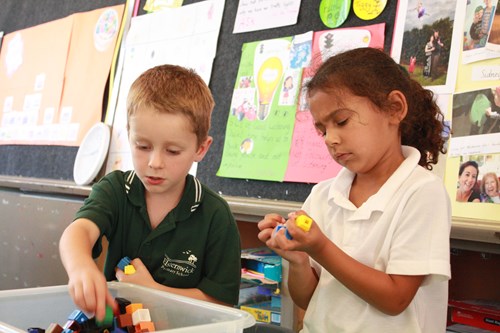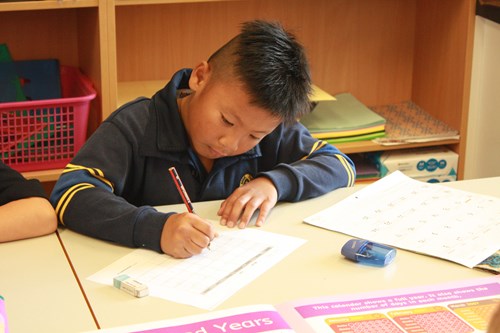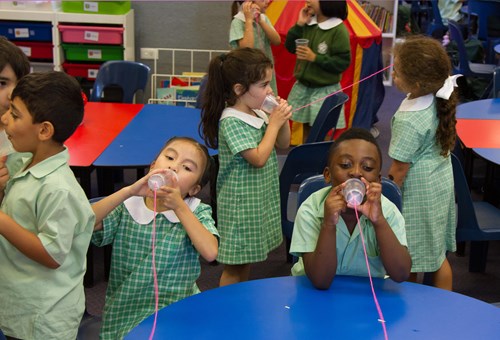Introduction
Welcome to the first Primary Matters for 2018. In this issue, we explore the new Literacy and Numeracy Learning Progressions, provide an update on the Digital Technologies in Focus project and explore the ways three schools are implementing the Australian Curriculum: Digital Technologies. We hope you enjoy reading this newsletter.
The National Literacy and Numeracy Learning Progressions are the latest addition to the ‘Resources’ section of the Australian Curriculum website. They have been developed to support teachers in implementing the Australian Curriculum: English and the Australian Curriculum: Mathematics.
What is the purpose of the progressions?
The progressions can assist teachers to locate where an individual student is in terms of his or her literacy and numeracy development, by helping them understand the typical sequence of learning for literacy and numeracy. The progressions are not tied to year levels as they recognise that students usually follow the same sequence or path of learning, albeit at different rates. The progressions also allow teachers to identify students who have not yet reached the age-equivalent expectations of the Australian Curriculum: English and Mathematics (and students who have exceeded them), so teaching can be adjusted to ensure all students make progress.
How will the progressions help teachers in primary schools?
Students acquire literacy and numeracy skills at different rates. For example, a student may enter Foundation knowing how to write his or her own name, while another student may be making pencil marks on a page. Another student in the same class may be producing short pieces of writing. It is the responsibility of the school and classroom teacher(s) to identify current levels of learning and teach the range of students so that they can work towards and achieve the standards set out in the Australian Curriculum: English and Mathematics.
Click on the images to see the full version
Elements of the National Literacy progression Elements of the National Numeracy Progression
How were the progressions developed?
The National Literacy and Numeracy Learning Progressions were developed for teachers to use in the classroom. The progressions are evidence-based and were trialled by over 600 teachers in schools across the nation in March–May last year. Following trialling and detailed teacher feedback, we released an amended version of the progressions for consultation with key ACARA stakeholders. The final version of the progressions was published on the ‘Resources’ section of the Australian Curriculum website in January 2018. State and territory school and curriculum authorities will make decisions about the use of the National Literacy and Numeracy Learning Progressions in their jurisdictions.
 As a part of the Australian Government’s National Innovation and Science Agenda, ACARA has been funded to support the implementation of the Australian Curriculum: Digital Technologies in some of Australia’s most disadvantaged schools.
As a part of the Australian Government’s National Innovation and Science Agenda, ACARA has been funded to support the implementation of the Australian Curriculum: Digital Technologies in some of Australia’s most disadvantaged schools.
One hundred and sixty schools with a low rating on the index of community socio-educational advantage (ICSEA) have been invited to participate in the project. From July 2017, leaders and teachers from these schools took part in workshops to support the implementation of Digital Technologies subjects within their schools.Eight Digital Technologies specialists (members of the Curriculum unit) have been supporting clusters of schools, providing digital technologies expertise to primary and secondary school teachers.
In 2018, the Digital Technologies specialists will conduct regional professional learning workshops with teachers and school leaders. These workshops will be customised to the specific needs of participating schools, with webinars and online mentoring complementing face-to-face events.
Click on the images to see the full version
Relationship between key ideas and Technologies subjects
 Going for a hole in one on King Island
Going for a hole in one on King Island
by Peter Lelong
Peter Lelong is supporting two clusters of schools in Tasmania (Hobart and the north-west coast). Peter has been a Digital Technologies educator supporting all three jurisdictions in Tasmania for many years.
King Island, with a population of under 2,000, is a remarkable island in the midst of Bass Strait, famous for its agricultural products, particularly cheese and beef. The island is not thought of as an aspiring hub for technological innovation; however, students and teachers at the King Island District High School are building their knowledge and skills in the use of a range of digital technologies. This is because their school, based in Currie with a population of nearly 190 F–10 students, is looking to build a program that will develop digital technologies innovation and creativity.
With the leadership of Principal, Ben Murfet, and Assistant Principal, Phil Holbrook, the staff recently joined the Digital Technologies in Focus project and registered in the Computer Science Education Research Group, University of Adelaide (CSER) Digital Technologies Massively Open Online Course (MOOC).
The project focuses on providing options and opportunities for students to stay on the island after school, to contribute to the community and to further the already flourishing local industries. The aim is to provide students with an awareness that the technologies they learn in school can be applied on a farm, in a tourism context or a golf links development.
To facilitate an understanding of the importance of digital literacy at King Island, students and their teachers have designed a golf hole at the school. Using drones, 3D printers and Lego robotics, the students are simulating how to design and project-manage an innovative solution. For example, they used a drone to provide an aerial image of the geographical landform, which assisted in choosing the most appropriate site for a golf hole.
 The students also used Lego EV3 robotics, experimenting with different designs for digging blades to be 3D-printed and tested in the school’s robotics room. Another challenge for the students might be to imagine and prototype a driverless mower using robotics and coding.
The students also used Lego EV3 robotics, experimenting with different designs for digging blades to be 3D-printed and tested in the school’s robotics room. Another challenge for the students might be to imagine and prototype a driverless mower using robotics and coding.
The school has plans to keep engaging with local farming and fishing communities to show the students how important digital technologies are across many areas of the island life.
Principal, Ben Murfet, has a clear vision on how he wants to build his school community:
“From the day I arrived on King Island, I have been looking to provide authentic learning opportunities that enable students to succeed in their chosen career path, whether that be on King Island or anywhere in the world. I want our students to achieve a balanced education, where we value outdoor play and love real experiences at the beach or in the backyard playing cricket. At the same time, I want our students to be aware of the essential skills required in the 21st century and be well-equipped to succeed in a fast-paced digital world. I want our students to be equally skilled in verbal communication, in catching a fish, in producing sophisticated code to create an entrepreneurial adventure.
“There is a clear desire to implement the Digital Technologies curriculum over the next three years across all year levels and I look forward to working with the schools in the Tasmanian clusters of north-west Tasmania and Hobart.”
 On the road with Digital Technologies Specialist, Sarah Hobson
On the road with Digital Technologies Specialist, Sarah Hobson
Sarah Hobson is supporting school clusters in south-west Queensland and northern New South Wales. Previously, she was an assistant manager, Technologies, at the Queensland Department of Education, where she quality-assured the Curriculum into the Classroom Technologies teaching and learning resources.
In June 2017, schools in the Barambah area of south-west Queensland participated in one of the first introductory workshops for the Digital Technologies in Focus project. After the workshop, the schools began work on their project proposals and shared their ideas via webinars. For Sarah Hobson, getting to know each school’s situation, school executive and teachers involved in the project was an important first step in supporting staff as they plan the implementation of the Australian Curriculum: Digital Technologies. Here are two of her stories…
Cherbourg State School: ‘Kids can code’ and ‘Creating Coding Queens’
The visit to Cherbourg State School was warm and friendly, and students and staff were very welcoming. Vanessa Boal, Head of Curriculum, introduced me to some of the unique programs running at the school, including an on-site kindergarten and a cultural knowledge centre for students to learn the Indigenous languages, Wakka Wakka and Kubi Kubi (also known as Gubbi Gubbi).
 With the support of local language speakers, cultural teacher Marilyn Huddleston works with Year 6 students to help them learn the language. They use the Miromaa computer program to capture words and phrases both from texts and audio recordings of elders.
With the support of local language speakers, cultural teacher Marilyn Huddleston works with Year 6 students to help them learn the language. They use the Miromaa computer program to capture words and phrases both from texts and audio recordings of elders.
Nicole Greenwood and Rechelle Marshall, members of the school’s DTiF project team, are doing amazing work with their students in Years 2, 3 and 4. I worked with the teachers to assist with student participation in the Bebras Computational Thinking Challenge. Vanessa and I assisted the students to interpret the questions so that they could work in teams and solve the problems. It was a challenging but rewarding experience, as the students had not encountered computational thinking challenges before. The data and lessons learnt were recorded as baseline data and observations for the project.
Murgon State School: ‘Drones and Digital Technologies’ project
I also visited Murgon State School and spent a day with Carmen Godbaz who is leading the DTiF project for the school. Carmen told me about plans for their project, which will involve gathering data on local tourism, programming drones to capture local landmarks and then sharing the information, using augmented reality, with tourists along the newly established South Burnett Rail Trail.
It was inspiring to see Carmen at work as she taught Year 3 students how to create drum kits using the Scratch programming language. Most of the students had not encountered visual programming before the lesson – and they were excited seeing their projects come together.
At lunch time, I attended the drone club and saw the joy on students’ faces as they learnt to maneuver the drones. Two Year 5–6 students, who were creating robotic solutions repurposing reclaimed pieces from old robotics kits, showed their working prototypes with great enthusiasm. This is a primary school driving change in their local area through their Digital Technologies activities!
Did you know?
The Australian Curriculum website houses a range of resources and publications to support schools in deepening their understanding of the Australian Curriculum and help teachers as they implement the curriculum.
The resources have been developed by ACARA after intensive work with schools and teachers. To see and use illustrations of practice, work samples, connections to the curriculum as well as links to reports and relevant research, visit the Australian Curriculum website and click ‘Resources/publications’.

Our next issue of Primary Matters will be published in June, with a focus on safety across the curriculum. How does your school approach child safety or e-safety? We’d love to hear from you! Send your story suggestions and feedback to danielle.cavanagh@acara.edu.au





